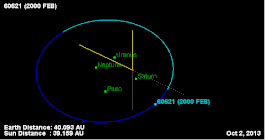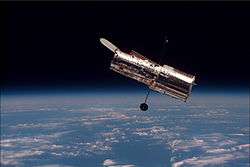(60621) 2000 FE8
(60621) 2000 FE8 is a scattered-disk object that resides in a distant, eccentric orbit that brings it 1.1 to 2.6 times farther than Neptune. This object is locked in a 2:5 orbital resonance with Neptune. It is known to have a single moon, S/2007 (60621) 1.[6]
 Orbit of (60621) 2000 FE8 | |
| Discovery [1][2] | |
|---|---|
| Discovered by | J. Kavelaars B. Gladman J.-M. Petit M. Holman |
| Discovery site | Mauna Kea Obs. |
| Discovery date | 27 March 2000 |
| Designations | |
| (60621) 2000 FE8 | |
| 2000 FE8 | |
| SDO · TNO | |
| Orbital characteristics [1][3] | |
| Epoch 4 September 2017 (JD 2458000.5) | |
| Uncertainty parameter 4 | |
| Observation arc | 6.80 yr (2,485 days) |
| Aphelion | 78.590 AU |
| Perihelion | 33.185 AU |
| 55.888 AU | |
| Eccentricity | 0.4062 |
| 417.81 yr (152,607 days) | |
| 30.201° | |
| 0° 0m 8.64s / day | |
| Inclination | 5.8614° |
| 3.8785° | |
| 144.17° | |
| Known satellites | 1 |
| Physical characteristics | |
| Dimensions | 152 km[4] |
Mean density | 1 g/cm3[4] |
| 0.09[4] | |
| Temperature | 37 K (-236°C) |
| (yellow-orange) B−V=0.75; V−R=0.48[5] | |
| 6.9[1] | |
Orbit
2000 FE8 has an extremely eccentric orbit which crosses the paths of many other trans-Neptunian objects, including almost all of the dwarf planets and dwarf planet candidates. As a result, its position alternates between the Kuiper Belt and the Scattered disk.[1]
Resonance with Neptune
2000 FE8 is part of a group of trans-Neptunian objects that orbit in a 2:5 resonance with Neptune.[7] That means that for every five orbits that Neptune completes, 2000 FE8 makes only two.[6] Several other objects are in the same orbital resonance, the largest of which is (84522) 2002 TC302.
Satellite
Like many objects of the Kuiper belt and scattered disc, 2000 FE8 has a satellite. Provisonally designated S/2007 (60621) 1, the satellite was discovered by the Hubble Space Telescope seven years after 2000 FE8 itself was found.[8] The moon orbits at 1180 kilometres away from 2000 FE8, completing one orbit in approximately 7 days.[4] It is thought to be 115 km[4] in diameter, just 75.7% the diameter of 2000 FE8 itself.
Numbering and naming
This minor planet was numbered by the Minor Planet Center on 14 June 2003.[9] As of 2018, it has not been named.[2]
Gallery
 Telescopes in the Mauna Kea Observatory, where 2000 FE8 was discovered.
Telescopes in the Mauna Kea Observatory, where 2000 FE8 was discovered. The Hubble space telescope, which discovered S/2007 (60621) 1.
The Hubble space telescope, which discovered S/2007 (60621) 1.
Notes
References
- "JPL Small-Body Database Browser: 60621 (2000 FE8)" (2007-01-15 last obs.). Jet Propulsion Laboratory. Retrieved 28 May 2017.
- "60621 (2000 FE8)". Minor Planet Center. Retrieved 24 February 2018.
- "List Of Centaurs and Scattered-Disk Objects (by semimajor axis)". Minor Planet Center. 4 October 2013. Retrieved 2013-10-04.
- Johnston, W. R. (26 November 2008). "(60621) 200 FE8". Johnston's Archive. Retrieved 2013-10-01.
- Tegler, S. C.; et al. (2003). "Color patterns in the Kuiper belt: a possible primordial origin" (PDF). Astrophysical Journal. Bibcode:2003ApJ...599L..49T. doi:10.1086/381076. Archived from the original (PDF) on 2017-09-22. Retrieved 2018-11-04.
- Johnston, W. R. (5 July 2013). "List of Known Trans-Neptunian Objects". Johnston's Archive. Retrieved 2013-10-05.
- Orbit and Astrometry for 60621
- Green, Daniel (3 March 2007). "Circular No. 8816" (PDF). Harvard. Retrieved 2013-10-05.
- "MPC/MPO/MPS Archive". Minor Planet Center. Retrieved 24 February 2018.